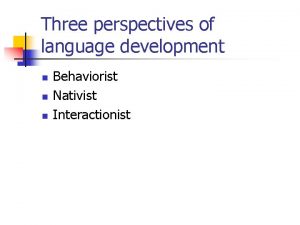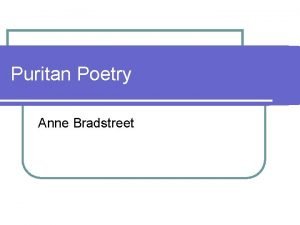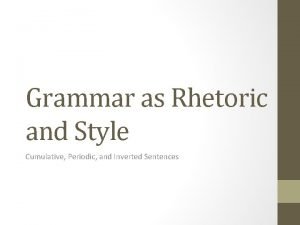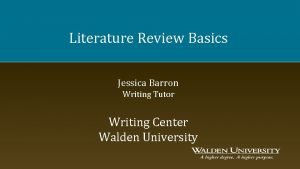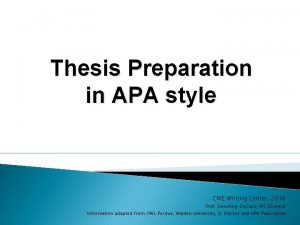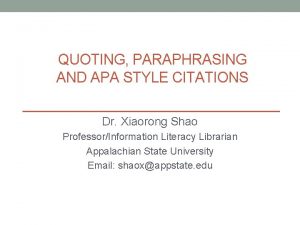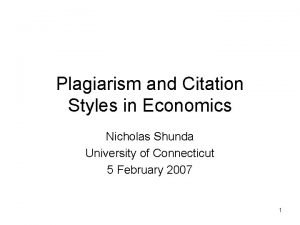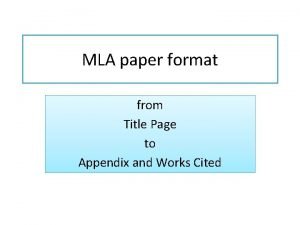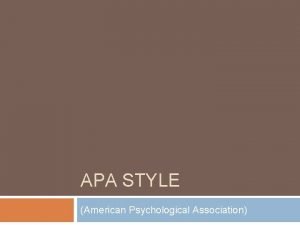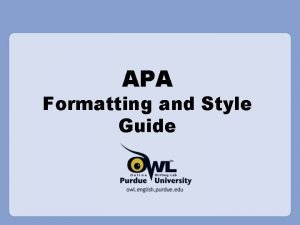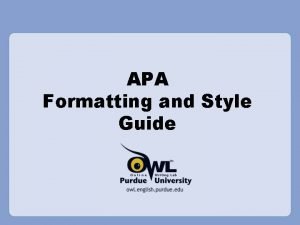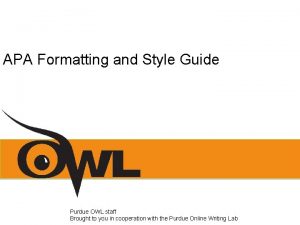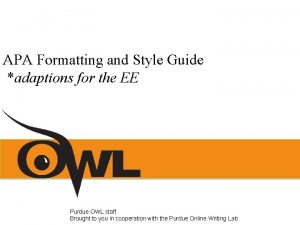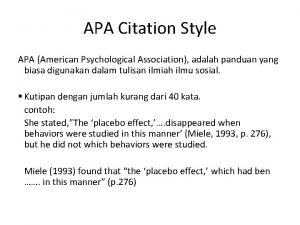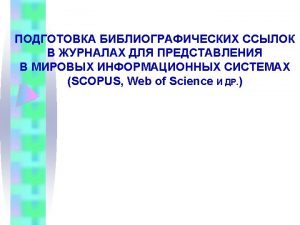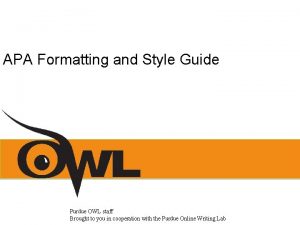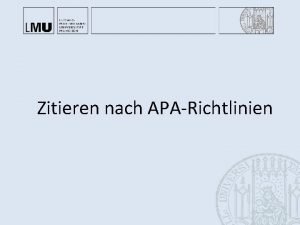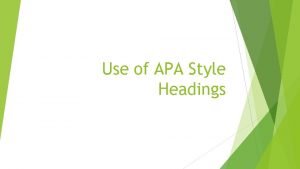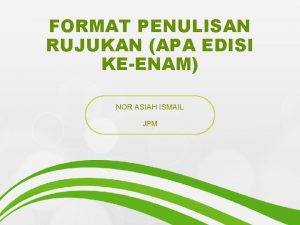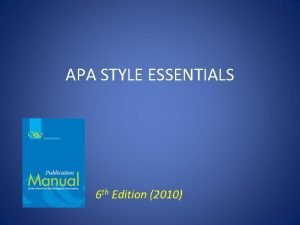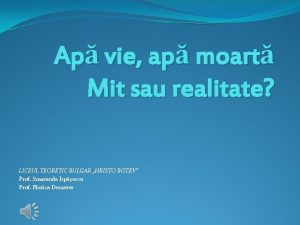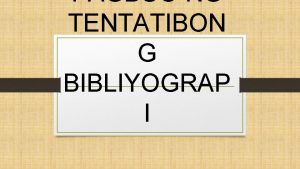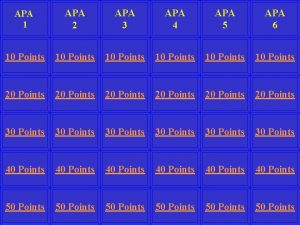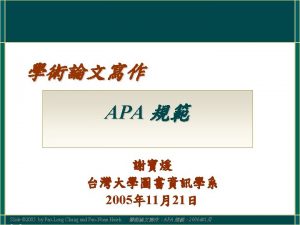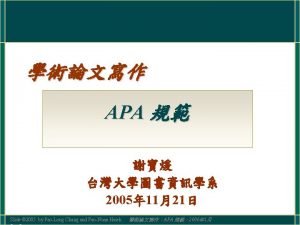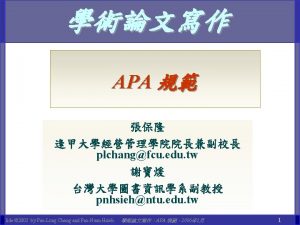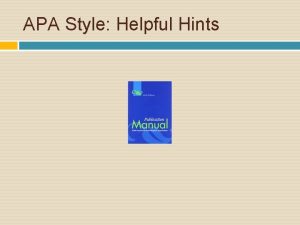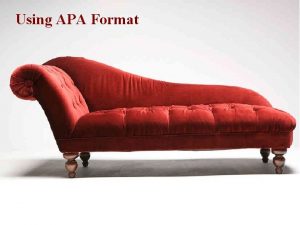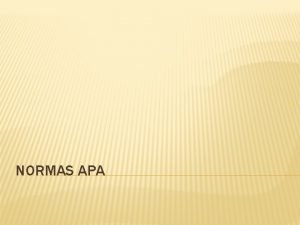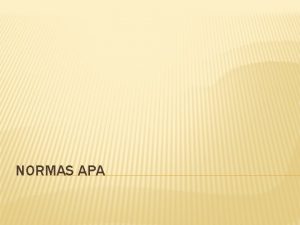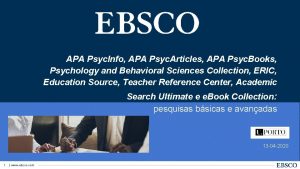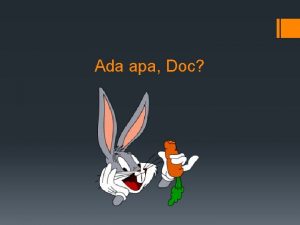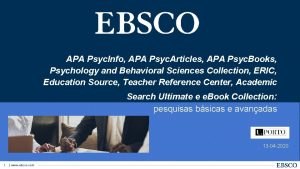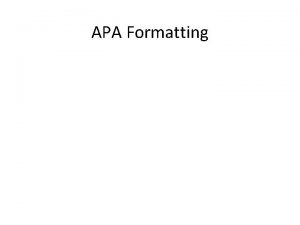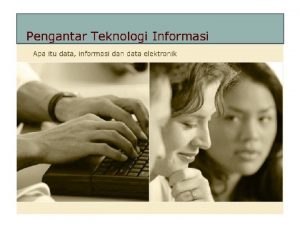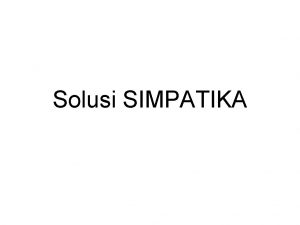APA Style Review What is APA Style n



































- Slides: 35

APA Style Review

What is APA Style? n n Publication Manual of the American Psychological Association, 5 th edition. APA Style refers to the format for submitting articles to journals (academic periodicals). APA is the most commonly accepted style for social sciences (history, sociology, psychology, economics, etc. ) and education. Bank Street College REQUIRES APA style for assignments.

General Format: n n n One-inch margins, with one inch at top and bottom. Paginate (number the pages) on top right corner. Double space throughout. Indent each new paragraph with the tab key; flush left with wide space between paragraphs is not APA style. Use a “hanging indent" for reference list. Use a general font, such as Times New Roman, Helvetica or Arial.

Reference Citations: n Every time you refer to an idea, work, study, or quotation from one of the sources you consulted, you need to cite that source. In other words, any part of your paper without citations must reflect your original ideas and work. n Citations are enclosed in parentheses, although parts of the citation may be a part of your text (narrative). If the full citation is at the end of a sentence, the period goes AFTER the closing parenthesis, and there is no period after the last word of your text. Use only authors’ surnames in citations. n n

The period goes at the end of the sentence, i. e. , after the closing parenthesis of the citation, if the citation is at the end of the sentence. Which one is correct? 1. The interpersonal problems of individuals with impaired object relations development have been amply described in both the analytic and family therapy literature. (Kernberg, 1975) 2. The interpersonal problems of individuals with impaired object relations development have been amply described in both the analytic and family therapy literature (Kernberg, 1975).

One author: Which one is correct? 1. Circumstances vary widely among American school districts. (Firestone, 1989). 2. Circumstances vary widely among American school districts (Firestone, 1989). 3. Circumstances vary widely among American school districts. (Firestone, 1989)

Two authors – always cite both names, and use an ampersand. Parents differ in their willingness to disclose their sexual orientation (Casper & Schultz, 1999). n However, if the authors’ names are part of your text, use “and”: Casper and Schultz (1999) found that parents differ in their willingness to disclose their sexual orientation. n NOTE that the date, in parentheses, immediately follows the author’s or authors’ name(s) when they are part of your text.

Three or more authors: For the first citation, include all the names. Barriers and borders exist between the home and school settings (Phelan, Davidson, & Yu, 1993). n When you cite the same work again, use et al. It is our job a teachers to make the transition from home to school as smooth as possible (Phelan et al. , 1993). n Note the correct usage of et al. (period, then comma).

Quotation marks enclose the quoted material. The period goes at the very end of the complete sentence, i. e. , after the closing parenthesis of the citation. Quotations always require a page number. Which one is correct? 1. “Writing friendly letters to parents is an excellent way for teachers to share their impressions about classroom happenings (Barclay, 2005, p. 196). ” 2. “Writing friendly letters to parents is an excellent way for teachers to share their impressions about classroom happenings” (Barclay, 2005, p. 196). 3. “Writing friendly letters to parents is an excellent way for teachers to share their impressions about classroom happenings” (Barclay, 2005).

If the quotation runs over to another page in your source, use pp. n “Acceptable solutions often become obvious once parents and school personnel have accurately understood each other” (Margolis, 1991, pp. 341 -342).

If you state the name of the author(s) as part of your text, place the date in parentheses DIRECTLY AFTER the name(s). Which one is correct? 1. As suggested by Barclay, we use anecdotes from our daily observations to illustrate what children are learning (Barclay, 2005). 2. As suggested by Barclay (2005), we use anecdotes from our daily observations to illustrate what children are learning. If there’s a quotation in this case, the page number(s) goes at the end. n Barclay (2005) suggests, “The use of anecdotal material helps parents understand what their children are learning” (p. 107).

Block quotes: If your quotation is over 40 words, indent one tab for the entire quotation, do not use quotation marks, and place the period at the end of the quotation, not after the closing parenthesis of the page number. Demchak and Drinkwater (1992) argue: Inclusion of these additional variables mirrors the current holistic emphasis in the education of children with special needs. Examination of other relevant factors that define successful integration efforts are as equally important as noting progress in development of children with disabilities. (p. 77) n NOTE: If the authors are not identified in your text before the quotation, the citation in parentheses would be: (Demchak & Drinkwater, 1992, p. 77) n However, most of the time the author(s) and date in parentheses will precede a block quote.

If you refer to the source but do not quote, you do not need a page number. Which one is correct? 1. This is a time to have patience, to listen, and to ask clarifying questions to help understand where the parents are coming from (Margolis, 1991). 2. This is a time to have patience, to listen, and to ask clarifying questions to help understand where the parents are coming from (Margolis, 1991, p. 332). Caveat: Paraphrasing Vs. Plagiarism

Citing a study mentioned in a work you consulted: n According to Billings, Pearson, Gills, and Shureen's study (as cited in Barrera & Corso, 2003), what seems to be a language problem may stem from cultural differences. n In the reference list for this citation, you would list Barrera & Corso, and NOT Billings, Pearson, Gills & Shureen. Your reference list should contain ONLY those works that you have consulted directly. You are directing your reader to your exact sources. n

Cite two or more works within the same parentheses in alphabetical order according to the authors’ surnames. Separate the citations with semicolons: Which one is correct? 1. Several studies show that family involvement plays a major role in student achievement (Swap, 1996; Epstein, 1998; Cook & Fine, 2001; Powell, 2004). 2. Several studies show that family involvement plays a major role in student achievement (Cook & Fine, 2001, Epstein, 1998, Powell, 2004, and Swap, 1996). 3. Several studies show that family involvement plays a major role in student achievement (Cook & Fine, 2001; Epstein, 1998; Powell, 2004; Swap, 1996).

Citing a personal communication: Give initials, surname, and exact a date as possible: n Knowing basic grammar is very important (K. Mc. Cracken, personal communication, July 20, 2006). n According to K. Mc. Cracken, knowing basic grammar is very important (personal communication, July 20, 2006). NOTE: Because this information is not recoverable, do not include personal communications in your reference list.

Reference List: n n n Center the title at the top of a separate page at the end of the paper: References (capital R, the rest not capitalized. Do not underline or make bold. If you only have one source, still create a new page and call it Reference. DO NOT title this page Bibliography, Works Cited, or anything other than References or Reference. This is an alphabetized (by author) list of sources that you have cited in your paper. All works should be cited in your paper. Use the “hanging indent” form – for each item, the first line should be flush left, subsequent lines are indented one tab space.

Authors: list last name and initials of author(s) – not full first name(s). Which one is correct? 1. Hacker, D. (2001). The Bedford handbook (6 th ed. ). Boston: Bedford/St. Martin’s. 2. Hacker, Diana. (2001). The Bedford handbook (6 th ed. ). Boston: Bedford/St. Martin’s. n Note: Do not italicize the edition reference in the title.

More than one author: note that there is a comma before the ampersand. Examples: n Rice, R. , & Porter, T. n Rice, R. , Porter, T. , & Mc. Cracken, K.

Book, chapter, and article titles are in sentence case (i. e. , first word, proper nouns, and first word after colon are capitalized; the rest is in lower case). Books: Barclay, K. (2005). Together we can: Forming partnerships with families. New York: Wiley. Hacker, D. (2001). The Bedford handbook (6 th ed. ). Boston: Bedford/St. Martin’s. (NOTE format for edition of book – parentheses, numeral, not italicized, “edition” abbreviated as “ed. ”, close parentheses, period. )

Chapter in an edited book: Porter, T. B. (2005). Crib notes on a complex issue. In R. Rice (Ed. ), Family, friend and neighbor child care: Research, practice, and policy (pp. 2 -11). New York: Bank Street College of Education. Journal article: Sussman, M. (1999). Effects of grade retention on Mexican immigrant children. Elementary School Journal, 25(1), 10 -36.

Journal titles are in title case. (All words are capitalized except articles, conjunctions and prepositions of three or fewer letters. ) Examples: n Elementary School Journal n Journal of Applied Psychology n Journal of Family and Children’s Studies

Book and journal titles are italicized; titles of articles in journals or chapters in edited books are NOT. Which one is correct? (This is a book. ) 1. Barclay, K. (2005). Together we can: Forming partnerships with families. New York: Wiley. 2. Barclay, K. (2005). Together we can: Forming partnerships with families. New York: Wiley.

NOTE: The volume of a journal, preceded by a comma, is also italicized. The number of the journal, which comes directly after the volume, in parentheses, with no space, is not italicized. The page numbers of a journal article follow the volume or number, without using “p. ” or “pp. ”

Which one is correct? (This is an article in a journal. ) 1. Sussman, M. (1999). Effects of grade retention on Mexican immigrant children. Elementary School Journal, 25(1), 10 -36. 2. Sussman, M. (1999). Effects of grade retention on Mexican immigrant children. Elementary School Journal, 25(1), 10 -36. 3. Sussman, M. (1999). Effects of grade retention on Mexican immigrant children. Elementary School Journal, 25(1), 10 -36. 4. Sussman, M. (1999). Effects of grade retention on Mexican immigrant children. Elementary School Journal, 25(1), 10 -36.

Handy guide: Use this for reference! n n Book titles: Italicized, sentence case Journal (periodical) titles: Italicized, title case Chapters in books: Plain format, sentence case Journal (periodical) articles: Plain format, sentence case

Chapter in an edited book: Porter, T. B. (2005). Crib notes on a complex issue. In R. Rice (Ed. ), Family, friend and neighbor child care: Research, practice, and policy (pp. 211). New York: Bank Street College of Education.

Order of references: Same author(s), different years: earliest first: n Rice, R. (1999). n Rice, R. (2005). Single author precedes multiple authors beginning with same name: n Porter, T. (2005). n Porter, T. & Rice, R. (2004). Same author, same year, two different works: n Porter, T. (2001 a). n Porter, T. (2001 b).

When the publisher is the same as the author: American Psychological Association. (2001). Publication manual of the American Psychological Association (5 th ed. ). Washington, DC: Author.

Place and Publisher Place of publication: This is the first city of publication listed on the copyright page. Spell out the city and use the two-letter state abbreviation without a period. For cities that are major publication centers (see below), leave out state abbreviation. Publisher – DO NOT include “Publishers, ” “Co. , ” or “Inc. ” if they are part of the publisher’s name. DO include “Books” and “Press. ” n n New York: Fireside Books. Hillside, NJ: Earlbaum. Cincinnati, OH: Mc. Laughlin Brown. Washington, DC: Democratic Press. Cities that need no state abbreviation: Baltimore, Boston, Chicago, Los Angeles, New York, Philadelphia, San Francisco.

Sample Reference List: References Barclay, K. (2005). Together we can: Forming partnerships with families. New York: Wiley. Porter, T. B. (2005). Crib notes on a complex issue. In R. Rice (Ed. ), Family, friend and neighbor child care: Research, practice, and policy (pp. 2 -11). New York: Bank Street College of Education. Porter, T. B. , & Rice, R. N. (2004). Kith and kin child care: Blessings and burdens. Washington, DC: Zero to Three. Sussman, M. (1999). Effects of grade retention on Mexican immigrant children. Elementary School Journal, 25(1), 10 -36.

Electronic Citations and References “At a minimum, a reference of an internet source should provide a document title or description, a date (either the date of publication or update or the date of retrieval, and an Internet address [URL])” (American Psychological Association, 2001, p. 269).

Citations in your text follow the same format as above. However, if the electronic source does not provide page numbers, use the paragraph number, or the heading and the paragraph number. n n (Rice & Mc. Cracken, para. 6) (Rice & Mc. Cracken, Discussion section, para. 3)

Reference list examples below are taken from the APA Manual, pp. 271 -272. Internet article based on a print source: Vanden. Bos, G. , Knapp, S. , & Doe, J. (2001). Role of reference elements in the selection of resources by psychology undergraduates [Electronic version]. Journal of Bibliographic Research, 5, 117 -123. Article in Internet-only journal Fredrickson, B. L. (2000, March 7). Cultivating positive emotions to optimize health and well-being. Prevention & Treatment, 3, Article 0001 a. Retrieved November 20, 2000, from http: //journals. apa. org/prevention/volume 3/pre 0030001 a. html NOTE: For more information on electronic sources, see APA Manual, pp. 268 -281.

Other things to consider APA also provides standards about other issues: n Concise and bias-free writing n Punctuation, spelling and capitalization n Italicizing and abbreviating n Numbers, metrication and statistics n Tables and figures n Footnotes and appendixes Concise Rules of APA Style (2005) is a handy guide.
 Chapter review motion part a vocabulary review answer key
Chapter review motion part a vocabulary review answer key Ap gov final review
Ap gov final review Nader amin-salehi
Nader amin-salehi What is inclusion and exclusion criteria
What is inclusion and exclusion criteria Narrative review vs systematic review
Narrative review vs systematic review Block letters format
Block letters format Formal and informal writing style
Formal and informal writing style Informal tone
Informal tone Referential vs expressive style
Referential vs expressive style Puritan style poem
Puritan style poem Periodic vs cumulative sentence
Periodic vs cumulative sentence Create your synthesis of review of related literature
Create your synthesis of review of related literature Anthropomorphism apa
Anthropomorphism apa Apa title page setup
Apa title page setup Cara membuat responsi
Cara membuat responsi What are direct quotes
What are direct quotes Apa style of referencing
Apa style of referencing Example of table
Example of table The apa style of referencing
The apa style of referencing How to do in text citation apa style
How to do in text citation apa style What is apa formatting style
What is apa formatting style Apa in text citation when there are multiple authors
Apa in text citation when there are multiple authors Purdue owl headings
Purdue owl headings Et al in text citations
Et al in text citations American psychological association (apa) style adalah
American psychological association (apa) style adalah Apa style пример
Apa style пример Purdue owl ama citation
Purdue owl ama citation Apa buchkapitel zitieren
Apa buchkapitel zitieren Apa style justified
Apa style justified Cara penulisan rujukan
Cara penulisan rujukan Apa style structure
Apa style structure Apa style guide
Apa style guide Apa style essentials
Apa style essentials Apa vie apa moarta marin sorescu
Apa vie apa moarta marin sorescu Mga dapat tandaan sa paggawa ng talasanggunian
Mga dapat tandaan sa paggawa ng talasanggunian Quarterly business review examples
Quarterly business review examples








